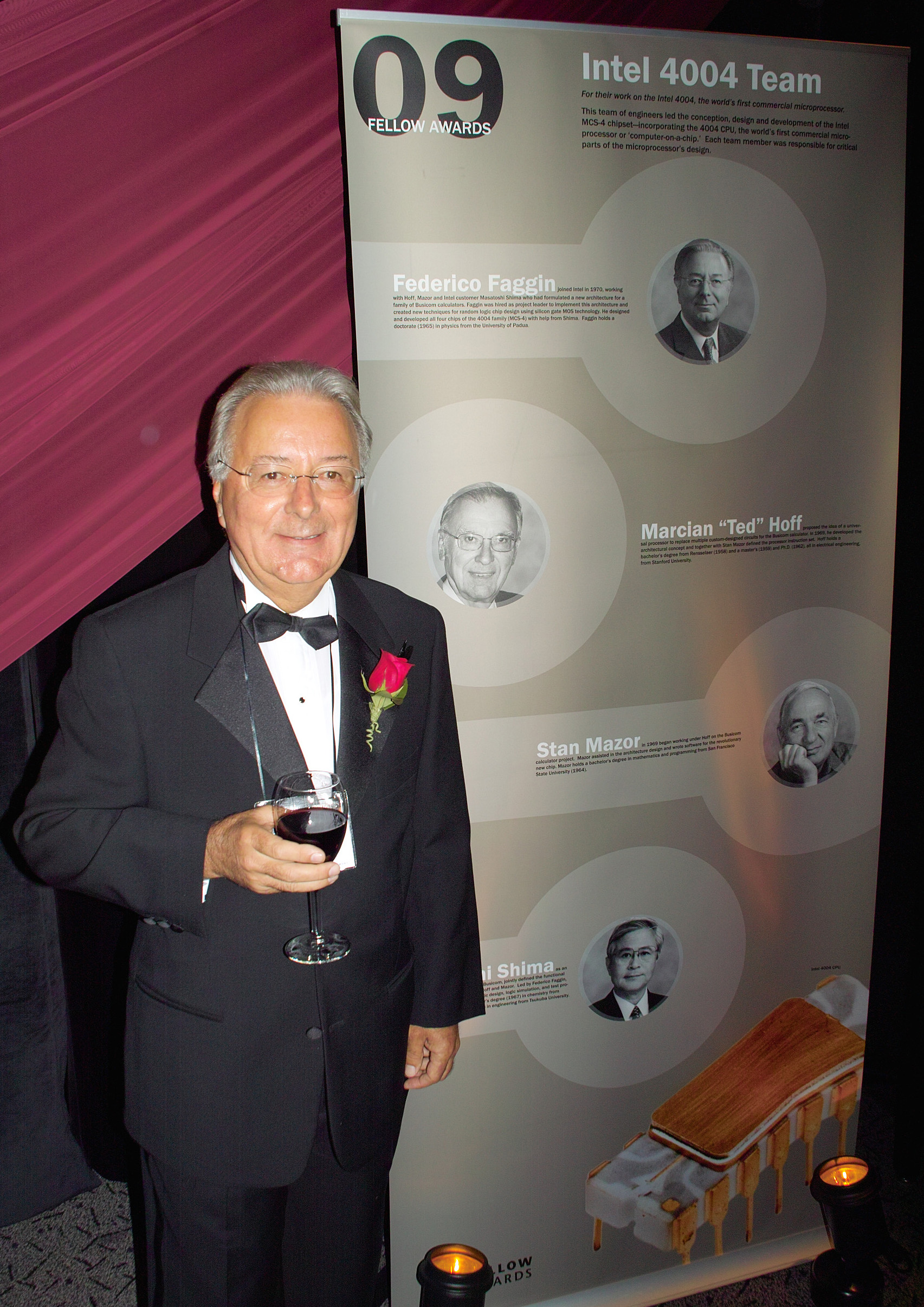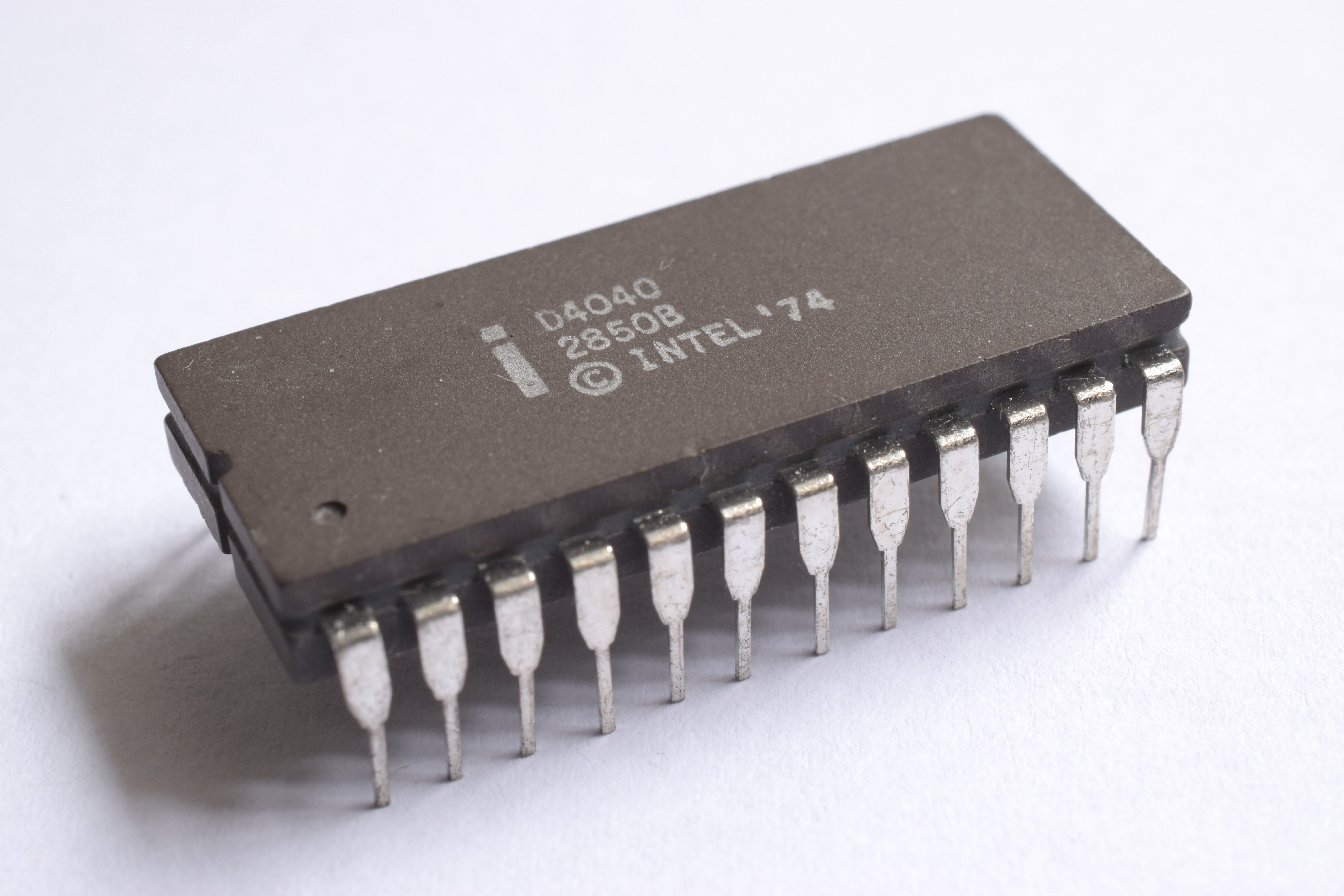|
MCS-4
The Intel 4004 is a 4-bit central processing unit (CPU) released by Intel Corporation in 1971. Sold for US$60, it was the first commercially produced microprocessor, and the first in a long line of Intel CPUs. The 4004 was the first significant example of large scale integration, showcasing the superiority of the MOS silicon gate technology (SGT). Compared to the incumbent technology, the SGT integrated on the same chip area twice the number of transistors with five times the operating speed. This step-function increase in performance made possible a single-chip CPU, replacing the existing multi-chip CPUs. The innovative 4004 chip design served as a model on how to use the SGT for complex logic and memory circuits, thus accelerating the adoption of the SGT by the world’s semiconductor industry. The developer of the original SGT at Fairchild was Federico Faggin who designed the first commercial integrated circuit (IC) that used the new technology, proving its superiority for a ... [...More Info...] [...Related Items...] OR: [Wikipedia] [Google] [Baidu] |
Federico Faggin
Federico Faggin (, ; born 1 December 1941) is an Italian physicist, engineer, inventor and entrepreneur. He is best known for designing the first commercial microprocessor, the Intel 4004. He led the 4004 (MCS-4) project and the design group during the first five years of Intel's microprocessor effort. Faggin also created, while working at Fairchild Semiconductor in 1968, the self-aligned MOS ( metal–oxide–semiconductor) silicon-gate technology (SGT), which made possible MOS semiconductor memory chips, CCD image sensors, and the microprocessor. After the 4004, he led development of the Intel 8008 and 8080, using his SGT methodology for random logic chip design, which was essential to the creation of early Intel microprocessors. He was co-founder (with Ralph Ungermann) and CEO of Zilog, the first company solely dedicated to microprocessors, and led the development of the Zilog Z80 and Z8 processors. He was later the co-founder and CEO of Cygnet Technologies, and t ... [...More Info...] [...Related Items...] OR: [Wikipedia] [Google] [Baidu] |
Intel 4040
The Intel 4040 microprocessor was the successor to the Intel 4004. It was introduced in 1974. The 4040 employed a 10 μm silicon gate enhancement load PMOS technology, was made up of 3,000 transistors and could execute approximately 62,000 instructions per second. General performance, bus layout and instruction set was identical to the 4004, with the main improvements being in the addition of extra lines and instructions to recognise and service interrupts and hardware Halt/Stop commands (the latter allowing operator-controlled single-stepping for debugging purposes), an extended internal stack and general-purpose "Index" register space to handle nesting of several subroutines and/or interrupts, plus a doubling of program ROM address range. New features *Interrupts *Single Stepping plus both hardware and software HALTing. *Low-power standbyEssentially a side function of Halt/Single Step; all internal processing would be suspended, and most of the chip hardware put int ... [...More Info...] [...Related Items...] OR: [Wikipedia] [Google] [Baidu] |
Microprocessor
A microprocessor is a computer processor where the data processing logic and control is included on a single integrated circuit, or a small number of integrated circuits. The microprocessor contains the arithmetic, logic, and control circuitry required to perform the functions of a computer's central processing unit. The integrated circuit is capable of interpreting and executing program instructions and performing arithmetic operations. The microprocessor is a multipurpose, Clock signal, clock-driven, Processor register, register-based, digital integrated circuit that accepts binary code, binary data as input, processes it according to instruction (computing), instructions stored in its computer memory, memory, and provides results (also in binary form) as output. Microprocessors contain both combinational logic and sequential logic, sequential digital logic, and operate on numbers and symbols represented in the binary number system. The integration of a whole CPU onto a s ... [...More Info...] [...Related Items...] OR: [Wikipedia] [Google] [Baidu] |
List Of Intel Microprocessors
This generational list of Intel processors attempts to present all of Intel's processors from the pioneering 4-bit 4004 (1971) to the present high-end offerings. Concise technical data is given for each product. Latest 13th generation Core Desktop (codenamed "Raptor Lake") 12th generation Core Desktop (codenamed " Alder Lake") Mobile (codenamed " Alder Lake") 11th generation Core Desktop (codenamed " Rocket Lake") Mobile (codenamed " Tiger Lake") 10th generation Core Desktop (codenamed " Comet Lake") Mobile (codenamed " Comet Lake", " Ice Lake", and " Amber Lake") 9th generation Core Desktop (codenamed "Coffee Lake Refresh") 8th generation Core Desktop (codenamed " Coffee Lake") Mobile (codenamed " Coffee Lake", " Amber Lake" and "Whiskey Lake") 7th generation Core Desktop (codenamed "Kaby Lake" and " Skylake-X") Mobile (codenamed "Kaby Lake" and "Apollo Lake") All processors All processors are listed ... [...More Info...] [...Related Items...] OR: [Wikipedia] [Google] [Baidu] |
Integrated Circuit
An integrated circuit or monolithic integrated circuit (also referred to as an IC, a chip, or a microchip) is a set of electronic circuits on one small flat piece (or "chip") of semiconductor material, usually silicon. Transistor count, Large numbers of tiny MOSFETs (metal–oxide–semiconductor field-effect transistors) integrate into a small chip. This results in circuits that are orders of magnitude smaller, faster, and less expensive than those constructed of discrete electronic components. The IC's mass production capability, reliability, and building-block approach to integrated circuit design has ensured the rapid adoption of standardized ICs in place of designs using discrete transistors. ICs are now used in virtually all electronic equipment and have revolutionized the world of electronics. Computers, mobile phones and other home appliances are now inextricable parts of the structure of modern societies, made possible by the small size and low cost of ICs such as mode ... [...More Info...] [...Related Items...] OR: [Wikipedia] [Google] [Baidu] |
Marcian Hoff
Marcian Edward "Ted" Hoff Jr. (born October 28, 1937 in Rochester, New York) is one of the inventors of the microprocessor. Education and work history Hoff received a bachelor's degree in electrical engineering from the Rensselaer Polytechnic Institute in 1958. He applied for his first two patents based on work done for the General Railway Signal Corp. of Rochester, New York during the summers of his undergraduate study. He received a National Science Foundation Fellowship to enroll in Stanford University, where he received his master's degree in 1959 and his Doctor of Philosophy, Ph.D. in 1962. As part of his Ph.D. dissertation, Hoff co-invented the least mean squares filter with Bernard Widrow. Hoff joined Intel in 1968 as employee number 12, and is credited with coming up with the idea of using a "universal processor" rather than a variety of custom-designed circuits in the architectural idea and an instruction set formulated with Stanley Mazor in 1969 for the Intel 4004—the ... [...More Info...] [...Related Items...] OR: [Wikipedia] [Google] [Baidu] |
Busicom
was a Japanese company that manufactured and sold computer-related products headquartered in Taito, Tokyo. It owned the rights to Intel's first microprocessor, the Intel 4004, which they created in partnership with Intel in 1970. Busicom asked Intel to design a set of integrated circuits for a new line of programmable electronic calculators in 1969. In doing this, they spurred the invention of Intel's first microprocessor to be commercialized, the Intel 4004. Busicom owned the exclusive rights to the design and its components in 1970 but shared them with Intel in 1971. Two other companies have done business as "Busicom" over the years: the ''Nippon Calculating Machine Corp, Ltd'' and subsequently ''Broughtons & Co. (Bristol) Ltd'' of the UK. Nippon Calculating Machine Corporation, Ltd History The ''Nippon Calculating Machine Corp'' was incorporated in 1945 and changed its name in 1967 to ''Business Computer Corporation'', Busicom. Due to a recession in Japan in 1974, B ... [...More Info...] [...Related Items...] OR: [Wikipedia] [Google] [Baidu] |
Small Scale Integration
An integrated circuit or monolithic integrated circuit (also referred to as an IC, a chip, or a microchip) is a set of electronic circuits on one small flat piece (or "chip") of semiconductor material, usually silicon. Transistor count, Large numbers of tiny MOSFETs (metal–oxide–semiconductor field-effect transistors) integrate into a small chip. This results in circuits that are orders of magnitude smaller, faster, and less expensive than those constructed of discrete electronic components. The IC's mass production capability, reliability, and building-block approach to integrated circuit design has ensured the rapid adoption of standardized ICs in place of designs using discrete transistors. ICs are now used in virtually all electronic equipment and have revolutionized the world of electronics. Computers, mobile phones and other home appliances are now inextricable parts of the structure of modern societies, made possible by the small size and low cost of ICs such as mode ... [...More Info...] [...Related Items...] OR: [Wikipedia] [Google] [Baidu] |
Programmable Calculator
Programmable calculators are calculators that can automatically carry out a sequence of operations under control of a stored program. Most are Turing complete, and, as such, are theoretically general-purpose computers. However, their user interfaces and programming environments are specifically tailored to make performing small-scale numerical computations convenient, rather than general-purpose use. The first programmable calculators such as the IBM CPC used punched cards or other media for program storage. Hand-held electronic calculators store programs on magnetic strips, removable read-only memory cartridges, flash memory, or in battery-backed read/write memory. Since the early 1990s, most of these flexible handheld units belong to the class of graphing calculators. Before the mass-manufacture of inexpensive dot-matrix LCDs, however, programmable calculators usually featured a one-line numeric or alphanumeric display. The Big Four manufacturers of programmable calcula ... [...More Info...] [...Related Items...] OR: [Wikipedia] [Google] [Baidu] |
Automatic Teller Machine
An automated teller machine (ATM) or cash machine (in British English) is an electronic telecommunications device that enables customers of financial institutions to perform financial transactions, such as cash withdrawals, deposits, funds transfers, balance inquiries or account information inquiries, at any time and without the need for direct interaction with bank staff. ATMs are known by a variety of names, including automatic teller machine (ATM) in the United States (sometimes redundantly as "ATM machine"). In Canada, the term ''automated banking machine'' (ABM) is also used, although ATM is also very commonly used in Canada, with many Canadian organizations using ATM over ABM. In British English, the terms ''cashpoint'', ''cash machine'' and ''hole in the wall'' are most widely used. Other terms include ''any time money'', ''cashline'', ''tyme machine'', ''cash dispenser'', ''cash corner'', ''bankomat'', or ''bancomat''. ATMs that are not operated by a financial in ... [...More Info...] [...Related Items...] OR: [Wikipedia] [Google] [Baidu] |





.jpg)
